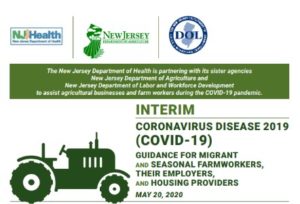
This event requires registration and there will be a follow-up survey.
- Rick VanVranken & Wes Kline, Agricultural Agents, Rutgers Cooperative Extension
- Secretary of Agriculture Doug Fisher, NJ Dept. of Agriculture
- Asst. Secretary of Agriculture Monique Purcell, NJDA
- Amanda Medina-Forrester, MA, MPH, Executive Director, Office of Minority & Multicultural Health, NJ Dept. of Health
- Christine Blumauer, Policy Advisor, Office of the Commissioner, NJ Dept. of Labor & Workforce Development
- Pete Furey, Exec. Director & Ben Cassella, Field Representative, NJ Farm Bureau
The NJDOH partnered with the NJDA and the NJDOL to create this guidance for agricultural employers focusing on precautions to help protect farm employees from COVID-19 on New Jersey farms and in farm labor housing. This webinar will review these guidelines. Questions from participants will be taken and addressed during the webinar.

